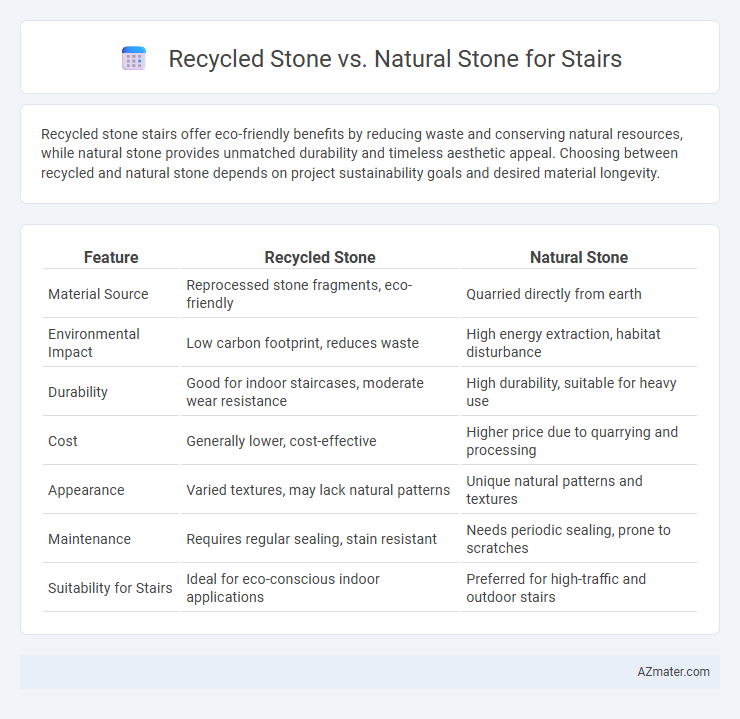Recycled stone stairs offer eco-friendly benefits by reducing waste and conserving natural resources, while natural stone provides unmatched durability and timeless aesthetic appeal. Choosing between recycled and natural stone depends on project sustainability goals and desired material longevity.
Table of Comparison
| Feature | Recycled Stone | Natural Stone |
|---|---|---|
| Material Source | Reprocessed stone fragments, eco-friendly | Quarried directly from earth |
| Environmental Impact | Low carbon footprint, reduces waste | High energy extraction, habitat disturbance |
| Durability | Good for indoor staircases, moderate wear resistance | High durability, suitable for heavy use |
| Cost | Generally lower, cost-effective | Higher price due to quarrying and processing |
| Appearance | Varied textures, may lack natural patterns | Unique natural patterns and textures |
| Maintenance | Requires regular sealing, stain resistant | Needs periodic sealing, prone to scratches |
| Suitability for Stairs | Ideal for eco-conscious indoor applications | Preferred for high-traffic and outdoor stairs |
Introduction to Recycled Stone and Natural Stone
Recycled stone for stairs is made from crushed concrete, brick, and other construction debris, offering an eco-friendly alternative that reduces waste and conserves natural resources. Natural stone, such as granite, marble, and limestone, is quarried directly from the earth, prized for its durability, unique patterns, and timeless aesthetic. Comparing both materials highlights differences in environmental impact, cost, and long-term performance for stair applications.
Composition and Manufacturing Process
Recycled stone for stairs primarily consists of crushed concrete, glass, and reclaimed aggregates bound by resin or cement, offering an eco-friendly alternative to natural stone. Natural stone, including granite, marble, and limestone, is quarried directly from the earth and cut into shapes without additional binding agents. The manufacturing process for recycled stone involves crushing, sorting, and binding waste materials, while natural stone undergoes extraction, shaping, and polishing to retain its intrinsic mineral composition and durability.
Environmental Impact and Sustainability
Recycled stone for stairs significantly reduces environmental impact by repurposing existing materials, minimizing quarrying and decreasing landfill waste. Natural stone extraction involves extensive mining that disrupts ecosystems and consumes high energy, contributing to carbon emissions. Choosing recycled stone supports sustainability through resource conservation and lowered carbon footprint while maintaining durability and aesthetic appeal.
Cost Comparison and Value
Recycled stone often offers a lower upfront cost for stairs compared to natural stone, making it an economical choice for budget-conscious projects. While natural stone provides higher durability and aesthetic appeal, recycled stone delivers substantial value through sustainability and reduced environmental impact. Balancing initial investment and long-term benefits is crucial, as natural stone can increase property value, whereas recycled stone supports eco-friendly construction trends.
Durability and Lifespan
Recycled stone stairs offer impressive durability, often resisting wear and weathering comparably to natural stone, but their lifespan can slightly vary depending on the source and processing methods. Natural stone, such as granite or limestone, generally boasts a longer lifespan of several decades to over a century due to its inherent toughness and resistance to erosion and heavy foot traffic. Both materials require minimal maintenance, but natural stone is widely recognized for its superior long-term structural integrity in stair applications.
Aesthetic Appeal and Design Flexibility
Recycled stone offers a unique aesthetic appeal characterized by a blend of varied textures and colors, providing an eco-friendly alternative with creative design flexibility for stair applications. Natural stone presents timeless elegance with consistent patterns and rich tones, ideal for classic or luxurious stair designs. Both materials allow customization, but recycled stone excels in sustainability-driven, contemporary settings while natural stone supports traditional architectural aesthetics.
Installation Process and Maintenance
Recycled stone stairs typically require a more precise installation process due to irregular shapes and variable sizes, often needing additional cutting and fitting compared to natural stone, which offers uniformity and easier handling. Maintenance for recycled stone stairs demands frequent sealing and cleaning to prevent damage from their porous nature, whereas natural stone stairs benefit from higher durability and simpler upkeep, resisting stains and wear over time. Both materials require professional installation to ensure structural integrity and safety on staircases.
Safety and Slip Resistance
Recycled stone used for stairs often incorporates textured surfaces or additives that enhance slip resistance, making it a safer choice in wet or high-traffic areas compared to some natural stones which can be smooth and slippery. Natural stone varieties like granite and slate naturally offer good slip resistance due to their rougher textures and inherent hardness, providing durable, long-lasting safety on stair surfaces. Choosing between recycled and natural stone for stairs should emphasize slip resistance ratings and surface treatments to ensure optimal safety for users.
Popular Applications in Stair Design
Recycled stone is increasingly favored in stair design for its environmental benefits and unique, rustic aesthetic, frequently used in eco-friendly residential and commercial projects. Natural stone, such as granite and marble, remains popular for its durability, elegance, and classic appeal, often chosen in luxury interiors and historic restorations. Both materials are utilized in stair treads, risers, and landings, with recycled stone offering a sustainable alternative while natural stone provides unmatched strength and timeless beauty.
Choosing the Right Stone for Your Stair Project
Choosing the right stone for your stair project involves weighing durability, environmental impact, and aesthetic preferences. Recycled stone offers an eco-friendly option with unique textures and patterns derived from repurposed materials, while natural stone provides unmatched strength and timeless beauty, often valued for its resistance to weathering and wear. Assess factors such as load-bearing requirements, maintenance needs, and budget constraints to determine whether recycled or natural stone best fits your stair design and functional goals.

Infographic: Recycled stone vs Natural stone for Stair
 azmater.com
azmater.com